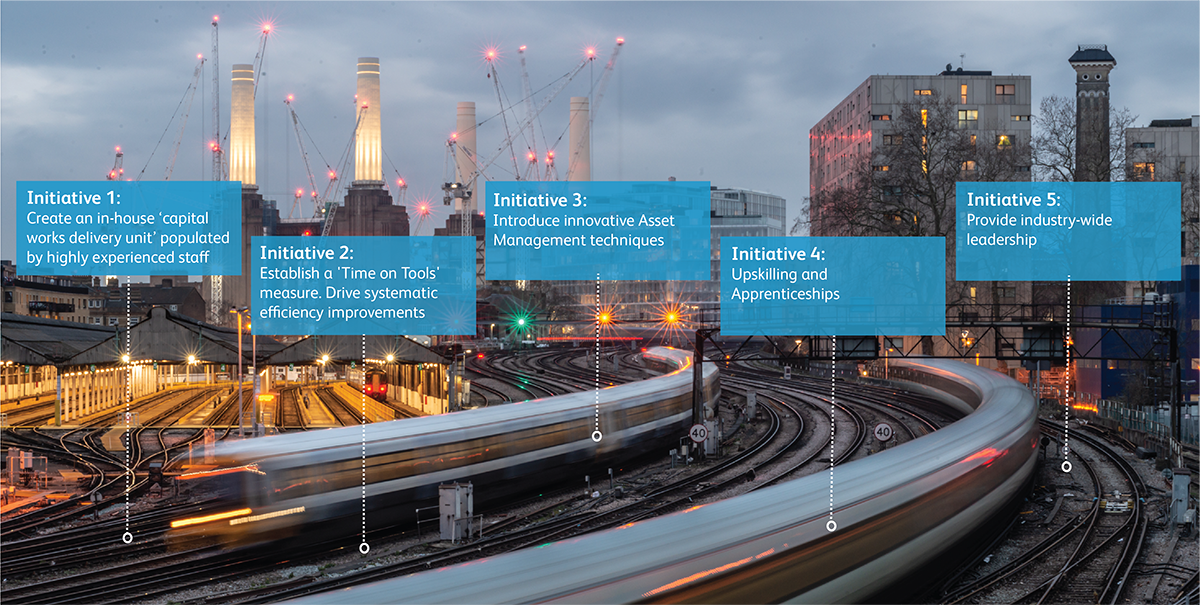Reducing Railroad / Transit Costs

A Case Study from the UK – A Matter of Survival in Today’s COVID-19 World
This paper shares how Network Rail, the national rail system owner and operator in the UK, implemented a number of long-term sustainable initiatives across its maintenance organization. The initiatives improved asset reliability, increased productivity from its maintenance workforce, and supported new ways of working, resulting in a higher performing system more focused on delivering the needs of its passengers at lower costs.
The combined outcome of these changes reduced Network Rail’s overall maintenance baseline costs and facilitated a lasting change to meet its other challenges. The initiatives were all completed with the full support of the transit unions.
Network Rail took over operating and maintaining Britain’s rail infrastructure in 2002 and in-sourced maintenance from contractors in 2004.
In the subsequent eight years, Network Rail reduced maintenance costs per train mile by 45%, reducing total operating and maintenance costs by 33%, while driving up safety and performance to world-leading levels.
Today, the COVID-19 pandemic is forcing transit agencies and railroads to address revenue and funding shortfalls. At the same time, many of these organizations also face pressures similar to those experienced by Network Rail in the early 2000s – the need to improve safety, improve service delivery for passengers, and collaborate better with staff and unions.
Network Rail drove their success through five transformational initiatives:
Initiative 1: Create an In-House ‘Capital Works Delivery Unit’ Populated by Highly Experienced Staff
Network Rail identified that a significant portion of maintenance effort was being applied to capital renewal activity. We created new capital works delivery units, transferring 2,500 of our highly experienced and skilled workforce into these units. This created an alternative career path for staff and encouraged competition and efficiencies from our contractors.
Initiative 2: Establish a 'Time on Tools' Measure. Drive Systematic Efficiency Improvements
Network Rail established a ‘time on tools’ (productivity) measure and carried out studies from both an asset - and a people-perspective. We introduced cyclical maintenance activities and planning processes to integrate different work types and align ‘Right of Way’ track access.
As a result, our effective time on tools increased by 60% in a three-year period and our ‘work outstanding’ dropped from 25% to 2%.
Initiative 3: Introduce Innovative Asset Management Techniques
We implemented techniques that drove a 30% reduction in asset failures affecting service, leading to a 46% reduction in train delays (which is a real cost for Network Rail). The techniques used included reassessing maintenance activities based on asset criticality and risk, application of technology to automate inspections and provide trend data, and introduction of Flight Engineers responsible for real-time monitoring of remote asset health condition data.
Initiative 4: Upskilling and Apprenticeships
To support the changes in culture, approach, and technology, Network Rail established new training centers for existing employees, established competence frameworks for all trades, and refocused the training program leading to a 240% increase in ‘new skills’ training.
We also added 1,000 new apprentices in a five-year window to create capacity within the organization for training and development while reducing the risk associated with high numbers of employees reaching retirement age.
Initiative 5: Provide Industry-Wide Leadership
Network Rail involved the unions at the earliest stages of planning. This generated a collective industry-wide approach where all were part of the solution. Data sets were readily available to support employees and allow them to focus on delivering the quantifiable improvements.
An ethos of sharing and learning was encouraged and was endorsed by reward and recognition schemes. This collective leadership led to the first ever union-supported performance-related pay agreement.
Our Offer to Transit and Rail Agencies
Through Network Rail Consulting, the consulting arm of Network Rail, we would be delighted to discuss more of the detail with you and how we can customize these solutions for your organization to help you emerge from the shared challenges stronger and more effectively than ever before.
If you are interested in learning more, please reach out to our regional contacts:
|
Chris Heald +1.917.561.0671
Simon Whitehorn +1.916.297.0900 |
Andrew Mitchem +1.917.239.8017
Gordon Williams +1.202.316.3343 |
Source Data:
Source data includes publicly available and internal Network Rail information.
https://www.raildeliverygroup.com/files/Publications/2017-12-industry-dataset.pdf
https://cdn.networkrail.co.uk/wp-content/uploads/2018/07/NRL-2018-ARA-Full.pdf

